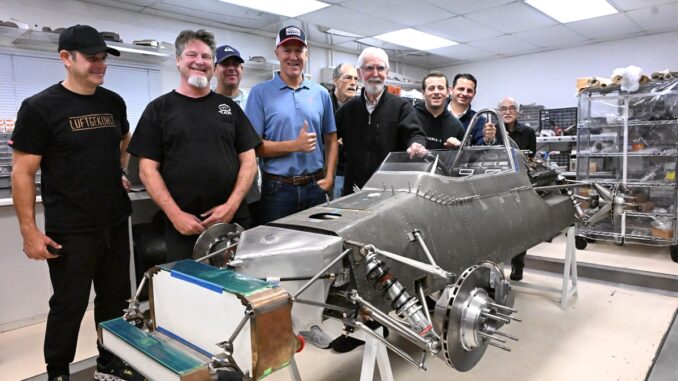

On the eve of its 49th event, one of the racing co-founders of the Acura Grand Prix of Long Beach had a birthday. Dan Gurney wasn’t around to celebrate his birth date on April 13, but a still-born Formula One car he was building at All American Racers (AAR) for the 1969 season has risen from the ashes. The magnesium-aluminum tub MkVI Eagle has been sitting since a tragic day of the 1968 F1 campaign.
It was during the French Grand Prix in 1968, held at Rouen, that Jo Schlesser had a big crash and fire in his Honda car which, like the Eagle of that era, had a magnesium tub (chassis). Seeing the breadth of that carnage, Formula One made the quick decision to ban magnesium tubs, while partner Goodyear’s desire to have Gurney’s squad focus on Indy car racing saw AAR and Gurney cancel the build of his Mark VI magnesium/aluminum chassis for the 1969 F1 season. The half-built tub, designed by Tony Southgate, went into a loft in the All American Racers workshops in Santa Ana, California. And sat.

While the bulk of the tub was magnesium, including its rivets, both the bulkhead and suspension were made of titanium. Whether Schlesser’s tragic and deadly fire at Rouen was due to these materials is disputable; the fact is he died, it was a tragedy and it caused Formula One and, ultimately Dan Gurney to rethink race car materials. And safety.
Today, of course, magnesium race cars are the stuff of history, and on April 13th, a big piece of history took place when, at Dan Gurney’s All American Racers workshops, the chassis plate for the one Mark VI chassis was put in place. It’s still not a runner, as its Gurney Eagle V12 engine is at Jim Stokes Workshops in the UK being rebuilt, but the car is on its way to running – for the first time – once the balance of the chassis is completed and the engine is installed. Southgate is lending his eyes and experience to this build; he’s consulted regularly.

Justin Gurney, who runs his father’s shop with the type of dedication one would expect from a son of Dan Gurney’s, has been instrumental in the three-year project to effect build of this car. While the chassis lay, gathering dust, among other stillborn projects, kept in a loft, the suspension and disc brakes – yes, it had disc brakes in 1968 – weren’t with the chassis. All the parts came home to roost once they were found and returned to Santa Ana.
One of the players in this journey is Terry Malone, who was one of Gurney’s first hires back in the mid-1960s. He’d been working on this car and, unknown to him, had suspension parts in his toolbox. They came back to the shop – and so did he – to tell the tales of the build and to celebrate its christening.

Malone, who went from AAR to Colin Chapman’s Team Lotus and was the chief mechanic on Mario Andretti’s cars during most of the 1969 Indianapolis 500 winner’s years driving for Chapman, was there when Gurney first sat in the car. To date, only Dan Gurney and his youngest son Alex have sat in the Mark VI; most likely, once the engine has been returned to Santa Ana, it will be Alex who lights the fire and brings this car to life.
Among the on-site to celebrate the Mark VI christening was the designer of AAR’s massively successful IMSA GTP racer, the Mk III. Hiro Fujimora, who designed that car and currently works with AAR on motorcycle wind tunnel testing, has been part of the team working on this Formula One car the past three years. He’s been joined by Frank Hanrahan, who was critical to the success of Danny Thompson’s revival of his father’s Challenger Land Speed Record car – also built in 1968 – reborn as Challenger II, which set the wheel-driven record at Bonneville (448.757 mph) 50 years after Thompson’s father Mickey’s last attempt.

John Zimmermann, who wrote the effective history of AAR’s race cars, Dan Gurney’s Eagle Racing Cars, took part in the christening, as well. His history of the Eagle breed is a technical one that celebrates the scope of Dan Gurney’s visions of racing, from his start throughout the business’ racing history.
Since April 13th was Dan Gurney’s birthday, it wouldn’t have been any better time to celebrate the christening of his once stillborn creation, a creation that will live to scream its V12 symphony. And Mk VI definitely won’t be a trailer queen. What a great way to celebrate a great man and racer!


Leave a Reply